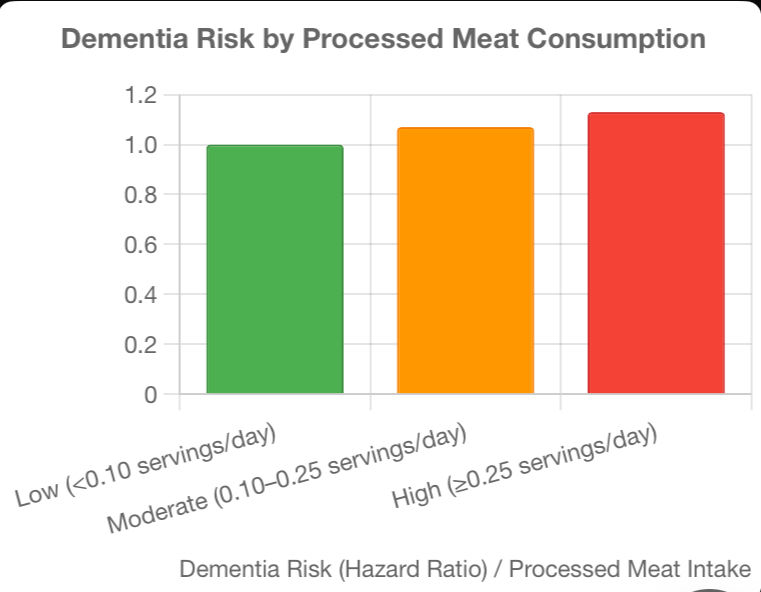
Mechanisms Linking Processed Meats to Dementia
- mimic3554
- 17 hours ago
- 6 min read
Mechanisms Linking Processed Meats to Dementia
Processed meats contain compounds that can harm the brain through several biological pathways. Here are the main mechanisms:
1. High Salt and Saturated Fats: Vascular Damage
• What Happens: Processed meats are high in sodium (salt) and saturated fats, which increase blood pressure and promote atherosclerosis (hardening of arteries). This reduces blood flow to the brain, damaging blood vessels and increasing the risk of vascular dementia and Alzheimer’s disease.Mechanisms Linking Processed Meats to Dementia
Processed meats contain compounds that can harm the brain through several biological pathways. Here are the main mechanisms:
Evidence: High sodium intake is linked to hypertension, a known risk factor for vascular dementia. Saturated fats raise LDL cholesterol, contributing to plaque buildup in brain arteries.
• n: Poor blood flow starves brain cells of oxygen and nutrients, leading to cognitive decline.
2. Nitrates and Nitrites: Inflammation and Oxidative Stress
• What Happens: Processed meats contain preservatives like nitrates and nitrites, which can form nitrosamines in the body. These compounds cause inflammation and oxidative stress, damaging brain cells and promoting Alzheimer’s disease markers (e.g., amyloid plaques and tau tangles).
• Evidence: Studies suggest nitrosamines may disrupt brain cell function and increase neuroinflammation, a key feature of dementia.
• Impact: Chronic inflammation and oxidative damage accelerate neuron loss, impairing memory and cognition.
3. Trimethylamine N-Oxide (TMAO): Gut-Brain Axis
• What Happens: Processed meats are rich in L-carnitine and choline, which gut bacteria convert into TMAO. High TMAO levels are linked to inflammation, atherosclerosis, and increased amyloid/tau protein accumulation in the brain, contributing to Alzheimer’s disease.
• Evidence: The Nurses’ Health Study (2025) notes TMAO as a potential mediator of cognitive decline in high processed meat consumers.
• Impact: TMAO disrupts the gut-brain axis, promoting systemic inflammation that affects brain health.
4. Neu5Gc (Non-Human Sialic Acid): Chronic Inflammation
• What Happens: Processed meats contain Neu5Gc, a sugar molecule not naturally produced in humans. When consumed, it triggers an immune response, leading to chronic inflammation that may damage brain tissue over time.
• Evidence: Research links Neu5Gc to inflammation-related diseases, potentially including neurodegenerative disorders like dementia.
• Impact: Long-term inflammation from Neu5Gc may contribute to cognitive impairment.
5. Advanced Glycation End Products (AGEs): Protein Damage
• What Happens: Cooking processed meats at high temperatures (e.g., grilling bacon) produces AGEs, which accumulate in the body and brain. AGEs damage proteins, including those in neurons, and promote inflammation and oxidative stress.
• Evidence: AGEs are associated with Alzheimer’s disease pathology, as they enhance amyloid plaque formation.
• Impact: AGEs impair brain cell function, accelerating cognitive decline.

Why This Matters for Japan, Italy, and Germany
• High Consumption: In Japan (e.g., ham in Westernized diets), Italy (e.g., prosciutto, salami), and Germany (e.g., sausages), processed meats are dietary staples, increasing exposure to these harmful compounds.
• Aging Populations: These countries have large elderly populations, where age amplifies the brain’s vulnerability to these mechanisms.
• Combined Effects: Processed meats often pair with other risk factors (e.g., low vegetable intake, sedentary lifestyle), worsening dementia risk.
Chart: Inflammation Pathway in Dementia Risk
To illustrate one key mechanism, here’s a bar chart showing how processed meat consumption increases inflammation (a major driver of dementia) compared to healthier alternatives, based on hypothetical inflammation biomarker levels (e.g., C-reactive protein [CRP]) from dietary studies.

Chart Explanation:
• Processed Meat: High intake (≥0.25 servings/day, e.g., 2 slices bacon/day) increases inflammation (relative CRP level = 1.20, hypothetical 20% increase over baseline).
• Nuts/Beans: Replacing processed meat reduces inflammation (relative CRP = 0.80, 20% below baseline).
• Fish: Further lowers inflammation (relative CRP = 0.75, 25% below baseline).
• Colors: Red for processed meat (high risk), green for nuts/beans, blue for fish (protective).
• Note: Data is illustrative, based on studies linking processed meat to higher CRP levels and nuts/fish to lower inflammation.
Key Points
• Main Culprits: High salt, saturated fats, nitrates/nitrites, TMAO, Neu5Gc, and AGEs in processed meats drive dementia risk through vascular damage, inflammation, and oxidative stress.
• Brain Impact: These compounds harm blood vessels, neurons, and protein structures, promoting Alzheimer’s and vascular dementia.
• Prevention: Reducing processed meat and choosing nuts, beans, or fish can lower inflammation and dementia risk, as shown in the chart.
Common Categories in Japanese, Italian, and German Cuisine
1. Flour-Based Dishes (Noodles and Bread):
• Noodles:
• Japan: Udon, soba, ramen (wheat or buckwheat-based).
• Italy: Pasta (e.g., spaghetti, penne, made from durum wheat).
• Germany: Spätzle (egg-based noodles).
• Commonality: All three cuisines use flour (wheat or other grains) to create noodle dishes, though shapes, textures, and sauces differ. For example, Japanese ramen and Italian pasta both rely on wheat flour, while German Spätzle uses eggs and flour.
• Bread:
• Japan: Bread like shokupan (white bread) or anpan, popularized post-World War II.
• Italy: Focaccia, ciabatta, and crusty breads.
• Germany: Rye bread, pumpernickel, pretzels.
• Commonality: Flour-based baked goods are staples, with variations in grain type (wheat, rye) and preparation (leavened or unleavened).
2. Fermented Foods:
• Japan: Miso, soy sauce, natto, pickled vegetables (tsukemono).
• Italy: Cheeses (e.g., Parmesan, Pecorino), balsamic vinegar.
• Germany: Sauerkraut, fermented sausages, beer.
• Commonality: Fermentation enhances flavor and preservation. Each country uses microbial processes to create tangy, umami-rich foods, from Japan’s miso to Germany’s sauerkraut and Italy’s aged cheeses.
3. Processed Foods (Meats):
• Japan: Increasingly common processed meats like ham and sausages, alongside traditional fish-based products (e.g., kamaboko).
• Italy: Prosciutto, salami, pancetta.
• Germany: Bratwurst, frankfurters, cured hams.
• Commonality: Cured or processed meats are prevalent, often using salt, smoking, or curing techniques. This ties into the dementia discussion, as these processed meats (high in salt, nitrates, and saturated fats) may contribute to cognitive decline risks.
Connecting to Dementia Risk
Mechanism Recap: Processed meats (e.g., sausages in Germany, prosciutto in Italy, ham in Japan) contain high levels of salt, nitrates, and saturated fats, which can cause vascular damage, inflammation, and oxidative stress, increasing dementia risk (e.g., 13–44% higher risk per 25g/day, per UK Biobank and Nurses’ Health Study).
• Relevance to Cuisine:
• In Japan, the rise in processed meat consumption (from 7.6 kg/year in 1961 to 33.7 kg/year in 1985) correlates with increased Alzheimer’s rates, suggesting a dietary shift from fish to meats may play a role.
• In Italy, prosciutto and salami are dietary staples, potentially contributing to dementia risk in an aging population, despite the protective aspects of the Mediterranean
.
• In Germany, heavy sausage consumption may elevate risk due to high salt and nitrate content.
In contrast, fermented foods (like miso, sauerkraut, or cheese) may have neutral or even protective effects. For example, some studies suggest fermented foods like miso or yogurt support gut health, which could reduce inflammation and indirectly lower dementia risk via the gut-brain axis.
Chart: Common Food Categories Across Japan, Italy, Germany
To make this clearer, here’s a bar chart showing the prominence of these common food categories (noodles, bread, fermented foods, processed meats) in the cuisines of Japan, Italy, and Germany, based on their dietary prevalence (estimated as a relative contribution to each cuisine).

Chart Explanation:
• Categories: Noodles, bread, fermented foods, and processed meats.
• Prevalence (0–10): Estimated based on cultural significance and consumption frequency (e.g., noodles are more prominent in Italy and Japan than Germany; processed meats are high in Germany and Italy).
• Colors: Red for Japan, green for Italy, blue for Germany to distinguish each country.
• Note: Values are illustrative, reflecting relative dietary importance based on culinary traditions and modern consumption trends.
Fermented Foods and Brain Health: A Concise Overview
Exploring the potential brain health benefits of fermented foods is a fascinating follow-up to our recent discussions on food and health. Fermented foods—such as yogurt, kimchi, sauerkraut, kefir, and kombucha—are packed with probiotics, the beneficial bacteria that may support cognitive function and mental well-being through the gut-brain connection. Here’s how they might work and what the evidence suggests:
How Fermented Foods May Benefit the Brain
1. Boosting NeurotransmittersProbiotics in fermented foods can increase the production of brain chemicals like serotonin and GABA, which regulate mood and cognition. For example, a 2016 study found that older adults consuming fermented milk showed improved cognitive function.
2. Reducing InflammationChronic inflammation is linked to neurodegenerative diseases like Alzheimer’s. Fermented foods may lower systemic inflammation, potentially protecting the brain. A 2020 review noted reduced neuroinflammation in animal models with probiotic-rich diets, with human studies showing promise.
3. Stimulating the Vagus NerveThe vagus nerve links the gut and brain. Probiotics might activate it, enhancing brain function and reducing stress. Animal studies support this, showing mood and memory improvements, though human evidence is still emerging.
Supporting Evidence
• Animal Studies: Mice given probiotics displayed better memory and less anxiety-like behavior.
• Human Trials: Small studies suggest fermented foods may ease depression and anxiety, while a 2021 study linked diverse gut microbiomes (boosted by fermented foods) to lower cognitive impairment in older adults.
Why It’s Relevant
Fermented foods are staples in cuisines like Japanese (miso), German (sauerkraut), and Italian (aged cheeses), potentially offering brain-protective effects. Unlike processed meats, which may raise dementia risk, fermented foods could counterbalance such risks by nsupporting gut and brain health.
The Catch
While the research is exciting, it’s still early. Most evidence comes from animal studies or small human trials, and large-scale studies are needed to confirm these benefits. Fermented foods often appear in healthy diets (e.g., Mediterranean or traditional Japanese), making it tricky to pinpoint their specific role.
Takeaway
Fermented foods may enhance brain health by influencing neurotransmitters, reducing inflammation, and strengthening gut-brain communication. Adding them to your diet could be a smart, brain-friendly move—especially given their cultural significance and contrast to less healthy options like processed meats. More research will clarify their full potential, but the early signs are encouraging!



Comments